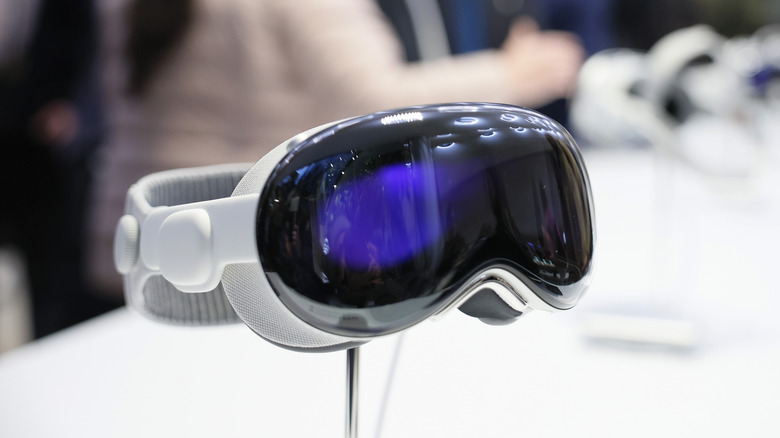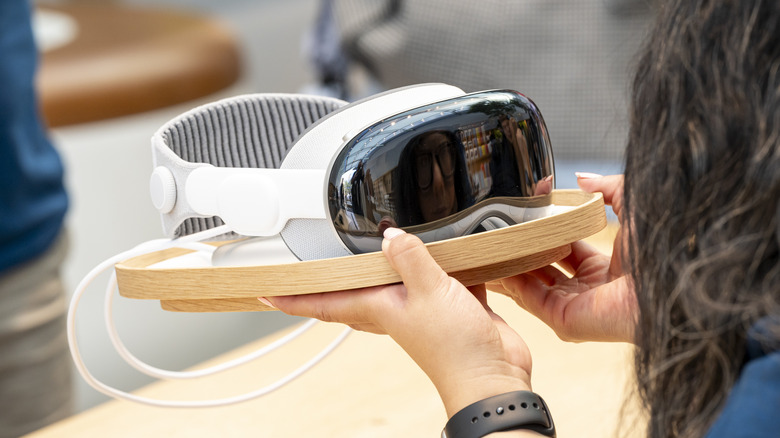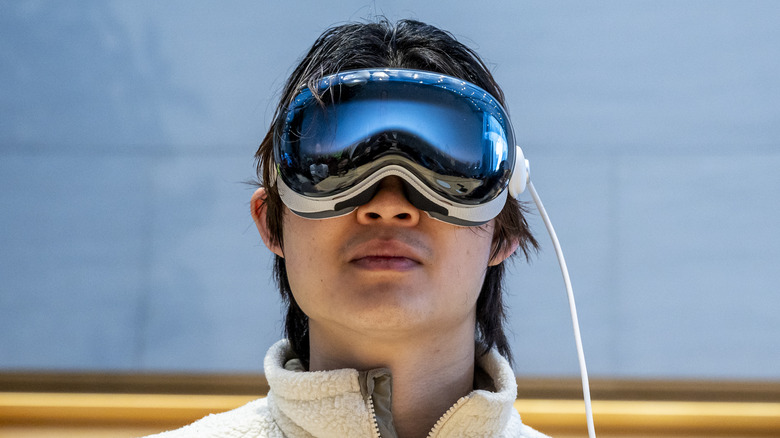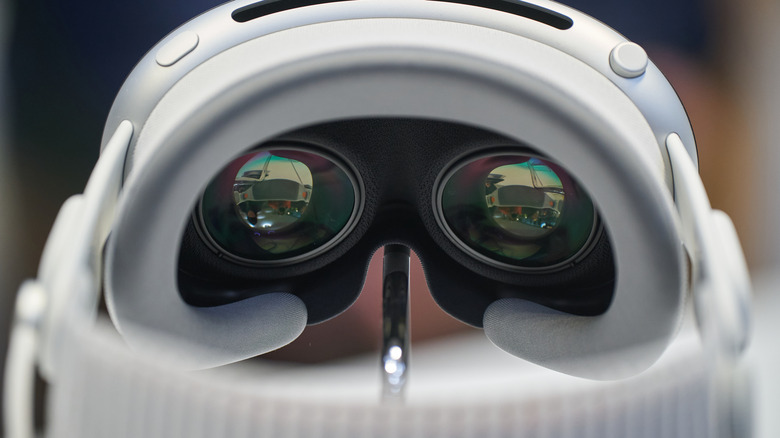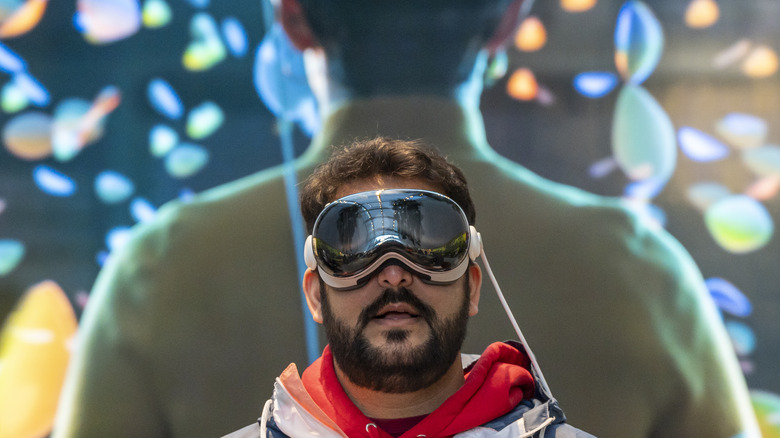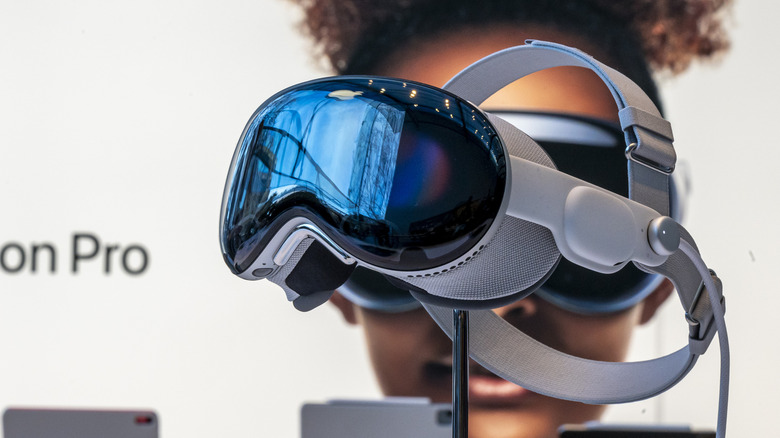5 Of The Biggest Apple Vision Pro Complaints We've Seen So Far
The Apple Vision Pro has been out in the world for a couple of weeks and has earned a good number of favorable reviews. However, as Bloomberg reports, there has also been a sizable number of returns for the product in this short amount of time. It's possible to assume those who purchased the headset immediately upon release are some of the biggest fans of Apple products out there. As such, if they are the ones returning their devices in larger than expected numbers, then it begs the question of what is wrong.
Complaints about this headset, which is meant to revolutionize how people use the Internet, watch movies, and experience things they can't see in person, have ranged a great deal as more and more people have put on the device. They include everything from how it works, how it feels, what it can do, and, in some cases, it just physically breaking without any major strain being put on it. Here, we are going to run down five of the biggest complaints levied at the Apple Vision Pro, and why people are returning it or not buying it at all in the first place.
It costs $3,500
People have a major problem with the Apple Vision Pro before even purchasing it. It has nothing to do with the device's functionality, its features, or anything practical about it. It simply has to do with the price tag on the product. Other headsets do cost quite a bit of money. The Meta Quest 3 costs $499. The Playstation VR2 is $50 more than that. Meanwhile, the Apple Vision Pro costs a whopping $3,500.
Buying a product that could very well cost more than twice the amount of your monthly rent is enormously impractical for the vast majority of people. If they are going to be spending that amount of money, the thing they buy better be something that is indispensable to daily life, and a luxury item like the Apple Vision Pro doesn't really present itself as one at this point. Seeing that people are returning the headsets after short periods of time doesn't make spending that kind of money any more appealing either.
It's too uncomfortable
Part of the appeal of a virtual reality, augmented reality, or mixed reality device is to allow you to lose yourself in the created, digital world. You want the suspension of disbelief to be so great that you don't even realize you are wearing a big pair of expensive goggles on your head for a long period of time. When it comes to the Apple Vision Pro, it leaves a lot to be desired on this front.
With a weight of 21.2 to 22.9 ounces, it is on the heavier side when it comes to similar headsets, but as the review for Digital Trends points out, it isn't so much the weight that is the issue but how the actual eyewear squeezes against the user's face. The comfortable material used for the headband doesn't offset that this large, bulky device needs to be strapped to your face as closely as possible so there is no leak from the real world, and that means your temples may suffer for it. This makes it difficult to use the Apple Vision Pro for long periods of time, and if someone wants to sink $3,500 of their own money into something, they probably want to be able to use it as much as possible.
There aren't enough apps yet
Part of the appeal of the Apple Vision Pro is that it lets you experience things in a new way. While that may be novel in a short demonstration at the Apple Store, the problem comes when you quickly realize that most of the things you are doing on your headset are things that you were perfectly fine doing with your other devices. For example, we have all become accustomed to sending out e-mails either on our computers or our smartphones. We may not like sending out e-mails, but typing them up isn't a particularly arduous process. If that is the case, why would you need to spend $3,500 on a device that does the same thing where the screen that sends an e-mail is floating in your line of sight?
This line of thinking can be applied to many of the features on the device, from looking at photos and videos to browsing the Internet. In some cases, it's actually a lesser experience if you are in a group and only have one Apple Vision Pro. You can't watch a movie together, and if you want someone else to see a photo in your library, you would have to take off the headset, which may be covered in sweat after using it, and put it on another person's head, where it might not fit properly because of the headband. Most of what an Apple Vision Pro does are just things we already do on other Apple products that we already own.
The field of vision is too narrow
For a headset device like this to be completely successful in its goal of being a totally immersive experience, the field of vision that the Apple Vision Pro needs would have to be as wide or wider than that of a person's eyes. Unfortunately, that does not seem to be the case with this particular headset. In reviews from places like The Verge, a major criticism is that there is something of a binocular effect while wearing an Apple Vision Pro headset, as if there is a black border surrounding the entire image you are seeing. If the potential discomfort wearing this device hasn't already taken you out of your immersion, then perhaps having a limited field of vision will.
In comparison to other headsets, the Apple Vision Pro doesn't even have the same field of view as the Meta Quest 3, which has a 110 degree horizontal and 96 degree vertical range. To go back to the first point on this list, this headset costs $3,500, and if you are getting an inferior immersion experience to something that costs thousands of dollars less, that could cause people to want their money back.
Some are cracking
One of the more surprising revelations that has come about in the few weeks that the Apple Vision Pro has been out in the world is that there have been several cases of headsets breaking. This isn't a software malfunction. The actual glass of the headset is physically cracking, and these breaks have reportedly been appearing for different customers in almost the exact same spot.
These vertical cracks are showing up almost directly in the middle of the main eyepiece and are quite large. As to what is causing the cracks, it's unclear. It could be a manufacturing issue. It could be a storage issue on the part of the customers. It could be a charging issue. What we do know is that it isn't people purposefully defacing their Apple Vision Pro headsets in order to spend hundreds of dollars on repairs, and repairing it yourself is enormously difficult. Having reports of a new $3,500 product breaking in the first few weeks seemingly out of nowhere is certainly not how Apple envisioned its rollout of the device going, but it's sure to make people a bit more cautious about spending that kind of money if it's just going to break. This is a small sample size, but it's concerning nonetheless.
